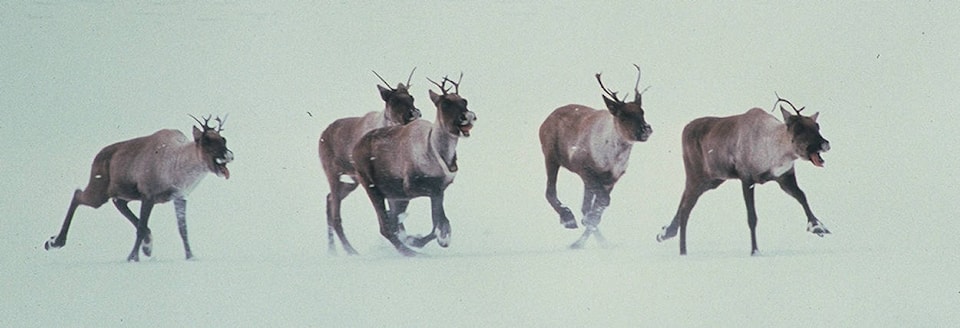It was during the late 1990s when Dave Quinn started researching the South Purcell caribou herd in Cranbrook. One hundred caribou made up the herd at the time, and the crew tracked them using radio collars, flying to remote areas with a little Cessna bush plane.
The Mountain Caribou has been likened to a canary in a coal mine; whose decline is an early indicator of a suffering ecosystem.
The South Purcell Mountain Caribou herd is the closest to Fernie. In 1995, there were 78, now, there are only 16.
“In the first few years of study we found the caribou using the last unlogged old growth,” said Quinn. “Pretty soon flagging tape would be there, next year a road, and the following year it would be gutted.”
He says that as fast as they could get their reports together and lobby for protection, their crucial habitat was vanishing.
Wildsight coordinator Eddie Petryshen says that the southern Mountain Caribou in B.C. are declining at an alarming rate. On Wednesday night, Wildsight, in partnership with the Yellowstone To Yukon Conservation Initiative held a film screening at The Arts Station in Fernie to raise awareness about the decline of one of Canada’s iconic animals.
The film, called Last Stand: The vanishing caribou rainforest, explores how the disappearance of inland temperate rainforests in B.C. are leading to the species’ demise.
The numbers of Mountain Caribou in the province have fallen from 2,200 in the 1990s to under 1,500 today.
“One of the most major sources of decline is habitat loss,” he said. “They’re super sensitive to habitat changes.”
The introduction of logging in the area, as well as the development of roads and trails have changed the caribou’s habitat over the past few decades.
The caribou rely on old-growth forests for sustenance, which as they are logged, reduce the areas available to the caribou.
“The decline of Mountain Caribou mirrors the decline of the equally rare inland temperate rainforest where they feed during the spring and fall,” said Petryshen, adding that the development of roads into the more remote areas has also led predators into their habitats that they previously didn’t have to deal with.“That’s something that has really affected populations,” he said, explaining that predator-prey dynamics have completely changed.
“Mountain Caribou migrate elevationally,” said Petryshen.
In the late winter, the caribou migrate higher into the mountains and feed exclusively on a high altitude lichen, which is their “evolutionary niche.”
“You have this species that’s evolved to live in this extreme climate,” said Petryshen.
The Mountain Caribou are a species adapted to navigate through heavy snowpack with their snowshoe-like hooves.
“They’re really a keystone species in terms of wilderness.”
A report from the federal Ministry of Environment and Climate change released last Tuesday says that caribou populations in the country are in grave danger. The Boreal Woodland Caribou, which was the focus of the report, was listed as a species at risk in 2012. Since then, the situation has only gotten worse.
“Habitat condition in the majority of ranges has worsened since 2012,” the report reads.
The Ministry says that the provinces have not been able to implement a strong enough plan to protect the populations successfully, and a joint, federally-led initiative is needed.
In B.C. there are three different caribou species,;the Woodland Caribou in southern and central parts of the province are listed as threatened. Populations of Northern and Mountain Caribou are also facing decline in the province.
Wildsight is currently working on developing more habitat protections as well as reconnecting isolated populations of Mountain Caribou so they can breed and share DNA.
“I think the Mountain Caribou is just so synonymous with Canadian culture,” said Petryshen. “I think it’s a really important story as we move into a changing climate.”
The last areas, like the Hellroaring Creeks that flow down through Montana desperately need preservation to keep the last of the South Purcell herd.
The creeks there and the unlogged valleys provide crucial protection for the herd from predators that usually feed on moose, deer and elk.
“I won’t say it’s too late,” said Quinn. “But we have really made our job difficult in terms of Mountain Caribou recovery by not being able to control ourselves when it came to logging.”
